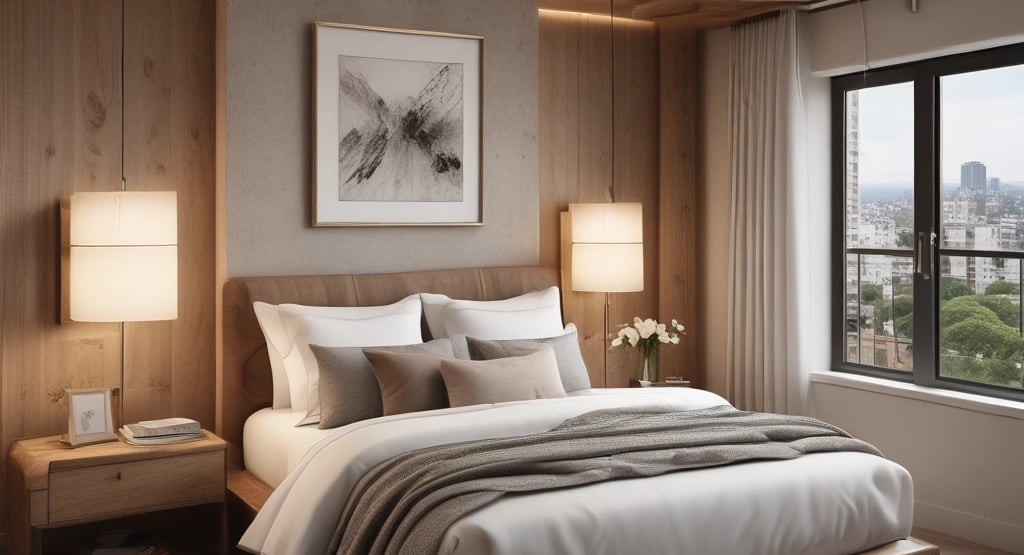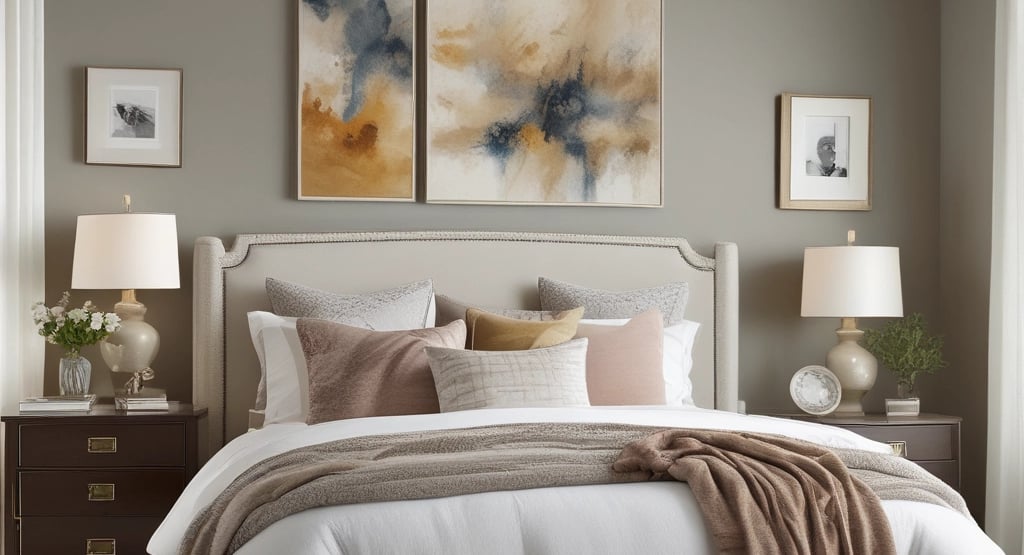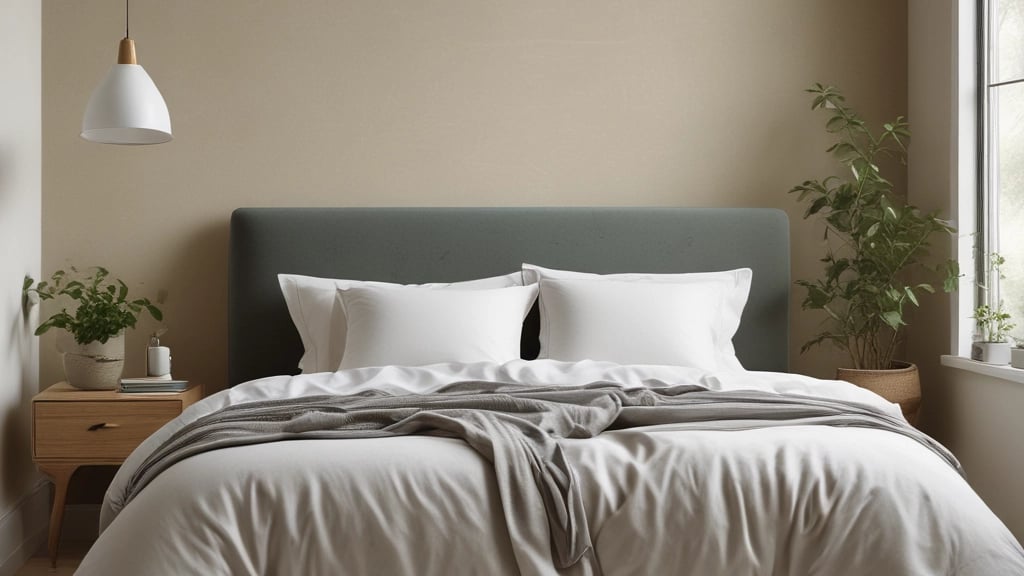Bedroom Interior Design: Creating a Comfortable and Stylish Personal Retreat
BEDROOMS
Mohamed Amine
10/27/202510 min read


Understanding the Essentials of Bedroom Interior Design
When embarking on bedroom interior design, it is essential to consider several fundamental principles that will enhance both the aesthetic and functional aspects of the space. Space planning is a critical element that involves arranging furniture and accessories in a manner that maximizes comfort and usability. An efficient layout not only promotes a smooth flow but also contributes to a sense of tranquility, which is paramount in a personal retreat.
Additionally, achieving style coherence throughout the bedroom is vital. Whether you lean towards a minimalist, contemporary, or eclectic design, each style carries its unique characteristics that influence the atmosphere of the space. Minimalist designs emphasize simplicity, using clean lines and a restrained color palette to evoke calmness. In contrast, contemporary styles incorporate current trends and often feature bold colors or patterns, allowing for personal expression. Eclectic designs, with their mix of various elements and styles, create an interesting and personalized environment, appealing to those who appreciate diversity in design.
It is crucial to establish a clear vision for your bedroom before making design decisions. Consideration should be given to personal preferences, lifestyle needs, and the overall mood you wish to create. This vision serves as a guiding framework that informs choices related to color schemes, furniture selection, and decor. Furthermore, functionality plays a significant role in interior design; the bedroom should cater to your daily activities, whether that involves relaxing, studying, or engaging in hobbies. By balancing aesthetic appeal with practical requirements, you can create a cohesive and inviting retreat that aligns with your lifestyle while reflecting your individual style.
Blending Comfort and Aesthetics in Modern Bedrooms
In the realm of modern bedroom design, achieving a harmonious balance between comfort and aesthetic appeal is paramount. The essence of a bedroom lies not only in its visual allure but also in its capacity to provide a tranquil sanctuary for relaxation. Selecting the right furniture is crucial; it should embody both functional usability and visual appeal. Contemporary trends increasingly favor pieces that combine ergonomic design with stylish elements, allowing homeowners to create spaces that cater to their physical comfort while enhancing the overall aesthetic.
When choosing furniture, consider pieces that accommodate and support the body, particularly in the bedroom where comfort is essential for quality sleep. Beds with quality mattresses, supportive headboards, and ergonomically designed nightstands exemplify this dual focus. Additionally, layering furniture pieces with inviting textures can significantly improve the ambiance of the space. Incorporating soft bedding, plush pillows, and cozy throws not only adds warmth but encourages an inviting atmosphere conducive to relaxation.
To further enhance the comfort of the bedroom, consider the role of color and lighting in the design. Soft, muted tones can evoke a sense of serenity, while adjustable lighting allows for versatility in creating a tranquil setting or a vibrant atmosphere. Integrating natural elements, such as plants or wooden accents, can also invoke a feeling of warmth and ease. These thoughtful choices contribute to a cohesive design where comfort is prioritized without compromising aesthetic appeal.
Ultimately, maintaining a clean and stylish look within the bedroom can be achieved through strategic organization and careful selection of design elements. Opting for storage solutions that remain functional yet fashionable can help declutter the space, promoting both visual harmony and comfort. By blending these aspects effectively, modern bedrooms can serve as both stunning showcases of design and nurturing retreats that enhance the quality of life.
Maximizing Space Through Smart Layouts and Furniture Choices
When it comes to bedroom interior design, optimizing space is crucial to create a comfortable and stylish retreat. Understanding different layouts is essential for enhancing both functionality and aesthetic appeal. For smaller bedrooms, consider utilizing corner spaces by positioning a bed against a wall or in a diagonal orientation. This not only saves space but also creates a cozy nook that invites relaxation. In larger bedrooms, you may have the luxury to experiment with separate zones for sleeping, studying, or leisure activities, effectively transforming the space into a multifunctional haven.
Smart furniture choices play a pivotal role in maximizing bedroom space. Selecting multifunctional furniture can dramatically increase utility without compromising style. For example, a bed with built-in drawers or a storage ottoman can help keep belongings organized while minimizing the need for additional furniture. Furthermore, choose items that are proportional to the room’s size; oversized furniture can make a bedroom feel cramped, while appropriately sized pieces maintain an open and airy atmosphere.
Creating flow is essential for a harmonious bedroom layout. Ensure that the placement of larger items, such as beds and dressers, allows for clear pathways and does not obstruct natural movement throughout the space. Strategically placing nightstands on either side of the bed not only provides convenience but also balances the overall composition. Designated areas for different activities help in maintaining clarity in the layout. For instance, incorporating a comfortable reading chair in a well-lit corner can encourage relaxation, while a small desk or vanity can support productivity without overcrowding the room.
By focusing on intelligent layouts and thoughtful furniture selections, anyone can transform their bedroom into a well-organized, inviting escape that blends comfort and style seamlessly.
Incorporating Colors, Textures, and Lighting for a Relaxing Mood
Creating a serene and inviting bedroom environment requires a careful consideration of colors, textures, and lighting. The color palette is perhaps the most vital aspect of setting a relaxing mood. Soothing and muted tones, such as soft whites, gentle blues, and muted greens, often evoke feelings of calmness and tranquility. When selecting colors, it’s beneficial to consider their psychological impact; for instance, shades of blue are known to promote serenity, while earthy tones can instill a sense of grounding. It is advisable to limit bold colors to accents or accessories rather than using them as dominant features, ensuring that the overall space retains a peaceful ambiance.
Incorporating various textures can further enhance the comfort level of a bedroom. Layering textiles such as plush throws, soft cushions, and luxurious bed linen adds depth and invites relaxation. Natural materials like cotton, linen, or wool contribute to an organic feel, inviting the senses to experience the comfort they provide. Additionally, a mix of textures in furnishings, such as a wooden headboard paired with a velvet bedspread, can create a visually appealing contrast that is both stylish and cohesive.
Lighting plays a crucial role in establishing a calming atmosphere. A combination of natural, ambient, and task lighting is essential for creating versatility while maintaining tranquility. Maximizing natural light through sheer curtains can enhance the room’s openness. For ambient lighting, consider using soft-glow lamps or dimmable ceiling fixtures which allow for control over the room’s brightness. Task lighting, on the other hand, should be strategically placed to ensure that essential activities, such as reading or working, do not disrupt the peaceful vibe. By mindfully integrating these essential elements colors, textures, and lighting you can transform your bedroom into a rejuvenating retreat that promotes relaxation and comfort, achieving the desired tranquil oasis.
Personalizing Your Bedroom with Décor and Art Elements
Infusing a bedroom with personal décor and art is essential for transforming it into a unique sanctuary that reflects individual tastes and life experiences. The selection of artwork, photographs, and decorative items can significantly contribute to creating an inviting ambiance. To begin, consider the overall theme and color palette of your room, as these factors will guide you in choosing pieces that harmonize with the existing décor while showcasing your personality.
When selecting artwork, explore various styles that resonate with you be it abstract, realism, or photography. Original pieces can be a great investment, but prints and eproductions are equally effective in adding character to your space. Personal photographs can also serve as poignant reminders of cherished moments; opt for frames that complement your room's design. Creating a gallery wall can serve as a focal point, where you can arrange various pieces in a cohesive manner. Use various frame styles and sizes to add depth, but maintain a unifying element, such as color or theme, to avoid visual clutter.
In addition to art, decorative items such as throw pillows, books, and sculptures can enhance your bedroom's overall aesthetic. These items should not overcrowd your space; rather, they should be thoughtfully arranged to maintain a sense of balance. It is crucial to incorporate elements of balance and proportion for effective visual harmony. For instance, if you have a large piece of art on one side of the room, consider adding a similar visual weight, like a tall plant or a shelf, on the opposite side to achieve equilibrium.
By carefully selecting and arranging these décor elements, you can create a bedroom that is not only stylish but also a true reflection of your personality, ultimately making it a comfortable and inviting retreat.
Creating a Cozy Atmosphere with Fabrics and Soft Furnishings
To establish a warm and inviting bedroom environment, the selection of fabrics and soft furnishings plays a crucial role. Textiles have the power to transform an ordinary space into a personal sanctuary by enhancing comfort and style. When choosing curtains, throws, and rugs, consider materials that not only provide visual appeal but also contribute to a cozy atmosphere.
Curtains can significantly influence the overall mood of the bedroom. Opting for soft, flowing fabrics such as cotton or linen can create a lighter feel, while heavier materials like velvet or thick drapery deliver a sense of warmth and security. It is advisable to select curtains that complement the color palette and overall theme of the room, as they can frame the window beautifully and add a touch of elegance.
Throws are another excellent way to incorporate softness into the bedroom. Soft blankets made of fleece or cashmere can promote relaxation, making it tempting to snuggle up with a book or simply enjoy the serene ambiance. These throws can also serve as decorative accents when draped over the bed or a chair, bringing both comfort and style to the space.
Rugs contribute significantly to the coziness of a bedroom. A plush area rug can soften hard flooring and provide a tactile layer underfoot, enhancing the comfort of the room. When selecting a rug, consider opting for natural fibers like wool or cotton, as they are not only durable but also add to the warmth of the bedroom. Layering rugs of different textures and sizes can create depth and visual interest, further enriching the inviting atmosphere.
In summary, by thoughtfully integrating a variety of fabrics and soft furnishings, you can create a cozy and stylish bedroom that serves as a personal retreat. With the right materials and layering techniques, it is possible to enhance both the aesthetic and comfort of your sleeping space, inviting relaxation and tranquility.
Sustainable Design Ideas for an Eco-Friendly Bedroom
Creating an eco-friendly bedroom is an essential step towards promoting sustainability in our living spaces. By selecting sustainable materials and implementing thoughtful design practices, one can significantly reduce their environmental impact while also enhancing personal comfort. A key aspect of sustainable design is the choice of materials. Opting for organic fabrics such as cotton, linen, or wool ensures that bedding and upholstery are free from harmful chemicals and pesticides. These materials not only support healthy indoor air quality but also provide a cozy atmosphere.
In addition to organic textiles, incorporating recycled furniture can further enhance sustainability in the bedroom. Reclaimed wood beds, dressers, and shelving not only reduce waste but also add unique character to the space. Choosing furniture made from sustainably sourced materials or built by local artisans helps to minimize the carbon footprint associated with transport and manufacturing. Moreover, a minimalist approach can significantly contribute to sustainable design. By reducing clutter and consumption, individuals can create a more serene environment that promotes relaxation and rejuvenation.
To optimize natural light, consider the placement of windows and the use of light-colored paint and furnishings that reflect sunlight. This can diminish the need for artificial lighting during the day, saving energy and enhancing the overall ambiance of the room. Additionally, incorporating indoor plants is a practical and stylish way to improve air quality and bring a touch of nature indoors. Plants such as snake plants or peace lilies require low maintenance and help to purify the air, contributing to a healthier living space.
Ultimately, adopting eco-friendly design principles in the bedroom fosters a more sustainable lifestyle. By prioritizing organic materials, recycled furnishings, and a minimalist approach, individuals can create a comfortable and stylish personal retreat that aligns with their values while also benefitting the environment.
Integrating Smart Technology for Modern Living Comfort
In today's fast-paced world, integrating smart technology into bedroom design has become essential for modern living. Smart devices can significantly enhance comfort and convenience, transforming a traditional bedroom into a stylish and functional sanctuary. Among the various available devices, smart lighting systems play a crucial role. These systems allow homeowners to adjust brightness and color temperature with ease, contributing to a calming atmosphere suitable for relaxation or bedtime reading. Additionally, programmable lighting can be set to gradually dim as bedtime approaches, helping to create a smooth transition into sleep.
Another pivotal element is the smart thermostat. This device enables precise temperature control and can be programmed to adapt to the user's schedule. For instance, a homeowner can set the thermostat to warm the bedroom before they arrive, ensuring a cozy environment upon entering. Some advanced systems even utilize sensors to detect when the room is occupied, automatically adjusting settings to maximize comfort and energy efficiency.
Voice-controlled assistants, such as Amazon Alexa or Google Assistant, can seamlessly integrate with various smart devices, providing a hands-free way to manage the bedroom environment. Users can control lighting, temperature, and even play calming music without lifting a finger, further amplifying the comfort of a modern bedroom retreat. However, it is crucial to ensure that these technological enhancements do not compromise the room's aesthetic. To achieve this balance, selecting devices that blend harmoniously with the existing décor is vital. For instance, opting for smart bulbs that fit into traditional light fixtures can maintain the expected visual appeal while offering modern functionality.
By thoughtfully incorporating smart technology, homeowners can create a comfortable and efficient bedroom that enhances their lifestyle. Utilizing these innovations not only elevates comfort but also contributes to a stylish and cohesive living space.
References
The Big Book of Interiors: Design Ideas for Every Room
Author: Agata Losantos
Link: The Big Book of InteriorsMy Bedroom is an Office: & Other Interior Design Dilemmas
Author: by Joanna Thornhill
Link: My Bedroom is an OfficeRoom by Room Recipes for Design (Home Decor Ideas)
Author: by Cathy Hobbs , Nigel Barker
Link: Room by Room Recipes for DesignMade for Living: Collected Interiors for All Sorts of Styles
Author: by Amber Lewis , Cat Chen
Link: The Interior Design HandbookCall It Home: The Details That Matter
Author: Various Authors






